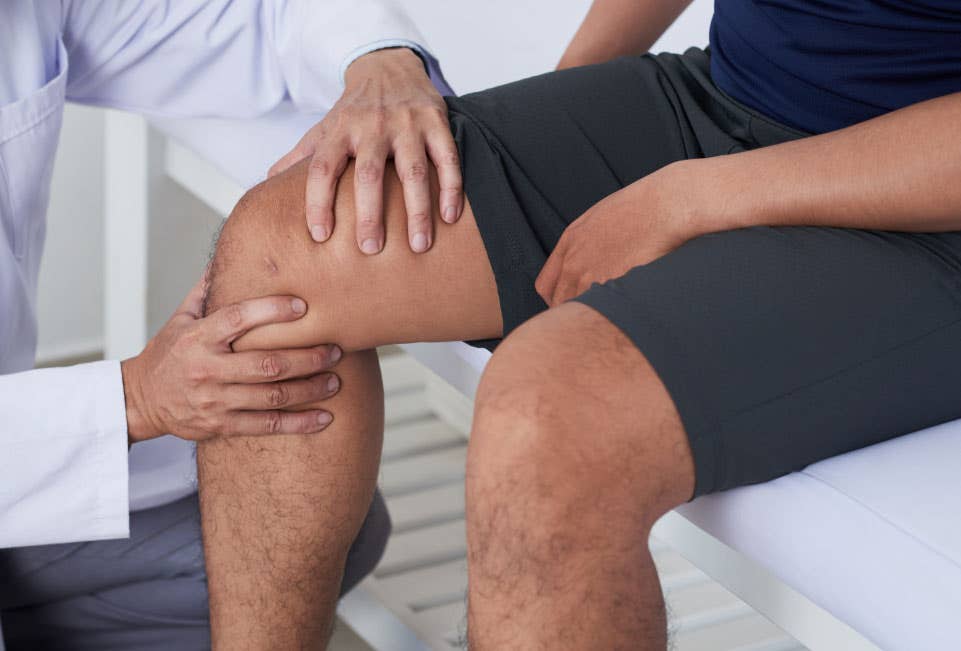Breakthrough artificial knee cartilage is more durable than natural tissue
A new gel-based material could serve as a replacement for knee cartilage. This innovative substitute is not only stronger but also more durable than natural cartilage.

The gel-based material offers a promising alternative to knee replacement surgery. (CREDIT: CC BY-SA 4.0)
Scientists at Duke University have developed a gel-based material that could serve as a replacement for knee cartilage. This innovative substitute is not only stronger but also more durable than natural cartilage.
The team, led by chemistry professor Benjamin Wiley and mechanical engineering and materials science professor Ken Gall, published their findings in the journal Advanced Functional Materials.
With knee pain caused by worn-out cartilage, or osteoarthritis, affecting nearly one in six adults worldwide, the potential impact of this breakthrough is significant.
The gel-based material offers a promising alternative to knee replacement surgery, which is often the only option for those with severe cartilage damage.
Sparta Biomedical, a company involved in the development and testing of the implant, has been conducting trials in sheep, and human clinical trials began in 2023. If successful, the implant could revolutionize treatment for individuals suffering from chronic knee pain.
In performance tests, the hydrogel demonstrated remarkable strength, proving to be 26% stronger in tension and 66% stronger in compression than natural cartilage.
Previous attempts to develop synthetic cartilage have struggled with securing the material in place, but the Duke team has addressed these challenges effectively, improving the implant’s stability and longevity.
To ensure the hydrogel remains firmly attached, the researchers designed a method that involves cementing and clamping it to a titanium base. This base is then pressed and anchored into a hole where the damaged cartilage once existed. The hydrogel closely mimics the smooth, slippery, and cushiony properties of natural cartilage, providing a more durable and effective solution for knee pain sufferers.
Knee pain is a widespread issue, particularly among aging populations. It can result from various causes, including injuries, repetitive stress, and medical conditions such as osteoarthritis. The latter is a progressive disease that leads to the gradual breakdown of cartilage, causing chronic pain, stiffness, and inflammation that can severely impact mobility and quality of life.
Related News
Osteoarthritis currently affects nearly 867 million people worldwide, making it one of the most common joint disorders.
As cartilage deteriorates, the bones in the joint begin to rub against each other, leading to pain and decreased function. Traditional treatments focus on pain management, physical therapy, and, in severe cases, joint replacement surgery, which carries significant risks and recovery time.
There are several treatment options available to alleviate knee pain, including over-the-counter pain relievers, physical therapy, and steroid injections. However, for some patients, these treatments are not enough to provide relief, and knee replacement surgery may be required.
Knee replacement surgery involves removing the damaged cartilage and replacing it with an artificial joint made of metal or polyethylene. While this surgery can be successful, it is a major operation that requires months of rehabilitation and can come with risks, such as infection and blood clots.
The hydrogel is made from thin sheets of cellulose fibers that are infused with a polymer called polyvinyl alcohol. The cellulose fibers act like the collagen fibers in natural cartilage, giving the gel strength when stretched, while the polyvinyl alcohol helps it return to its original shape. The resulting material is a Jello-like substance that is 60% water but is surprisingly strong.
The researchers found that the hydrogel can be pressed and pulled with more force than natural cartilage and is three times more resistant to wear and tear. Natural cartilage can withstand up to 8,500 pounds per inch of tugging and squishing before breaking, while the lab-made version can handle even more. It is 26% stronger than natural cartilage in tension and 66% stronger in compression.
In addition to being stronger, the hydrogel mimics the smooth, slippery, cushiony nature of real cartilage, protecting other joint surfaces from friction as they slide against the implant.
The researchers tested the implant's wear over time by spinning artificial cartilage and natural cartilage against each other a million times, with a pressure similar to what the knee experiences during walking.
Using a high-resolution X-ray scanning technique called micro-computed tomography, the scientists found that the surface of the implanted cartilage remained smooth and intact after the million rotations, indicating that it had minimal wear and tear.
The researchers were thrilled with the results of their testing, as it suggested that the implant could potentially last for many years without needing to be replaced. However, they knew that further testing would be necessary to confirm their findings and to ensure that the implant was safe and effective for use in humans.
To this end, the team began planning a series of animal studies to evaluate the implant's long-term safety and effectiveness. They also began exploring potential partnerships with medical device companies to help bring their technology to market and make it available to patients in need.
As news of the breakthrough spread, the research team received numerous accolades and awards for their work. They were even invited to present their findings at international conferences and symposia, where they shared their insights with other researchers and medical professionals.
Despite the recognition they received, the researchers remained focused on their ultimate goal: to develop a safe and effective implant that could help improve the lives of people with knee osteoarthritis. And with each new study and experiment, they came one step closer to achieving that goal.
Note: Materials provided above by The Brighter Side of News. Content may be edited for style and length.
Like these kind of feel good stories? Get The Brighter Side of News' newsletter.
Joseph Shavit
Head Science News Writer | Communicating Innovation & Discovery
Based in Los Angeles, Joseph Shavit is an accomplished science journalist, head science news writer and co-founder at The Brighter Side of News, where he translates cutting-edge discoveries into compelling stories for a broad audience. With a strong background spanning science, business, product management, media leadership, and entrepreneurship, Joseph brings a unique perspective to science communication. His expertise allows him to uncover the intersection of technological advancements and market potential, shedding light on how groundbreaking research evolves into transformative products and industries.



